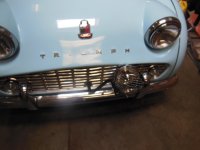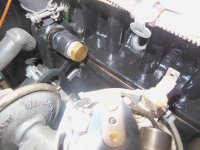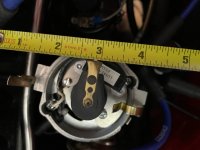I've been taking a little vacation from the TR issues while Florida temperatures were breaking records. We had three days of 106F. which is unprecedented. During that time, I kept wondering what could cause my timing to be jumping around and not steady. It seemed like the engine problems were solved except for the distributor. I spoke with Pertronix a few times and ran all the tests they directed me to do and convinced them (and me) the distributor is ok although the timing still jumps around about 3/4 of an inch on the pulley at 1200 and above.
With all other options eliminated, I put my other new coil on the engine for the second or third time and checked the timing. After the switch the timing became much steadier. The timing now jumps between 1/8 and 1/4 of an inch. This is more in the realm of slop in the mechanical end. (wear on timing gear, end play of the distributor drive shaft, and wear of the key in the drive shaft.)
I set the timing to 5 deg btdc at 600 rpm and took the car out for a spin. For the first time in five years, the car ran perfectly!! I could not get a backfire under any conditions. I drove home and did a final adjustment on the carbs (one flat on each) and drove again with equally good results.
In summary, I believe there were several issues with the engine which caused backfire through the carbs and very rich running which the community on this forum helped me to unravel.
- One carb had a leak in the jet gasket which allowed fuel to bypass the jet and go directly into the engine. New neoprene seals eliminated that leak.
- Excessive friction on the jet seals caused the jets to not fully retract when the choke was released. The jets stuck about .060 before coming home. New jets with a polished OD reduced the friction allowing the jets to fully come "home" when the choke was released.
- One major discovery was that the oil I was using in the dashpots was too thin for my driving conditions. Initially I was using 3 in 1 oil, followed by 10W30 and finally 30W oil. I had always read comments that the oil weight was not too important, but I now think it is. I'm going to play with different weights and carb adjustments until I get brown spark plugs.
- The fuel pump seemed to be underperforming so I put a rebuild kit into it and it seemed to perform better. The old check valves were not completely sealing. I'm not sure if this contributed to the issues, but the effort eliminated that possibility. The fuel filter was also replaced at that time.
- My original distributor had a leaky diaphragm which was replaced without solving the problem. I also replaced the vacuum line from the carb to the distributor. Still backfired. New points, plugs and condenser did not help. A new timing light combined with a great article on how to diagnose distributor wear issues helped me to decide the distributor had to go. I either needed to rebuild it or buy a rebuilt one. I had the Pertronix distributor here, so I put it on and the backfire issues were not solved!
- Today, I put on the other coil I have (both coils are new) and the backfire issues finally disappeared.
It's been a very long journey for me and I could not have done it without all of your help. Several issues combined contributed to the problems I was experiencing and your expert guidance helped me to eliminate the problems one by one.
It's probably early to claim victory, but in time I'll see if the plugs turn brown and the exhaust pipe gray. Does anyone know how many hours of driving this should take?
Thanks again to everyone who contributed. I'm forever grateful.
Ken


 Hey Guest!
Hey Guest!
 smilie in place of the real @
smilie in place of the real @
 Pretty Please - add it to our Events forum(s) and add to the calendar! >>
Pretty Please - add it to our Events forum(s) and add to the calendar! >> 


